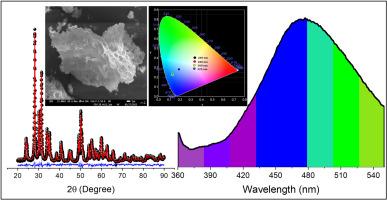ZrO2 纳米粒子中 Ce 稳定四方相的结构和光学特性以及单斜相的强烈蓝光发射
IF 3.6
3区 物理与天体物理
Q2 OPTICS
引用次数: 0
摘要
本文介绍了铈稳定四方二氧化锆(ZrO2)的结构和光学特性以及单斜二氧化锆的强烈蓝光发射。本文采用溶液燃烧法制备了稳定的四方和单斜二氧化锆纳米粒子。X 射线衍射研究和衍射图样的里特维尔德细化表明,在掺入 Ce 后,ZrO2 稳定在四方相(t-ZrO2)。主掺杂离子尺寸失配导致了晶格畸变,从而形成了 t-ZrO2 稳定相。拉曼模式证实了 ZrO2 从单斜相到四方相的相变。样品中氧空位和表面态的存在改变了光带隙。掺杂的 Ce 离子会产生缺陷/氧空位,这些缺陷/氧空位是电子和空穴/供体和空位相关杂质水平的捕获点。正是这些层次之间或脱位导带之间的转变导致了带隙的减小。光致发光研究揭示了与结构相变相关的发射带的存在。单斜相(m-ZrO2)显示出强烈的蓝色发射,这是由于 m-ZrO2 中 Zr 的氧配位不对称且不寻常。色度坐标表明,制备的材料和采用的策略适合光电应用领域。本文章由计算机程序翻译,如有差异,请以英文原文为准。

Structural and optical properties of Ce-stabilized tetragonal phase and intense blue emission of monoclinic phase in ZrO2 nanoparticles
Structural and optical properties of Ce-stabilized tetragonal zirconium dioxide (ZrO2) and intense blue emission of monoclinic ZrO2 are presented in this paper. Nanoparticles of ZrO2 in the stabilized tetragonal and monoclinic phases have been prepared by the solution combustion method. X-ray diffraction studies and Rietveld refinement of the diffraction pattern show the stabilization of ZrO2 in the tetragonal phase (t-ZrO2) with Ce doping. It is the host-dopant ionic size mismatch that leads to lattice distortion and hence the t-ZrO2 stabilized phase. Raman modes confirm the phase transformation from the monoclinic to a tetragonal phase of ZrO2. The presence of oxygen vacancies and surface states in the samples play a role in altering the optical band gap. The dopant Ce-ions create defects/oxygen vacancies, which act as the trapping sites for electrons and holes/the donor and vacancy-related impurity levels. It is transition between these levels or between delocalized conduction bands that lead to band gap reduction. Photoluminescence studies reveal the presence of structural phase transformation dependent emission bands. The monoclinic phase (m-ZrO2) exhibits an intense blue emission originating from the asymmetric and unusual oxygen coordination of Zr in the m-ZrO2. The chromaticity coordinates indicate that the prepared material and adopted strategies are suitable in the field of optoelectronic application.
求助全文
通过发布文献求助,成功后即可免费获取论文全文。
去求助
来源期刊

Journal of Luminescence
物理-光学
CiteScore
6.70
自引率
13.90%
发文量
850
审稿时长
3.8 months
期刊介绍:
The purpose of the Journal of Luminescence is to provide a means of communication between scientists in different disciplines who share a common interest in the electronic excited states of molecular, ionic and covalent systems, whether crystalline, amorphous, or liquid.
We invite original papers and reviews on such subjects as: exciton and polariton dynamics, dynamics of localized excited states, energy and charge transport in ordered and disordered systems, radiative and non-radiative recombination, relaxation processes, vibronic interactions in electronic excited states, photochemistry in condensed systems, excited state resonance, double resonance, spin dynamics, selective excitation spectroscopy, hole burning, coherent processes in excited states, (e.g. coherent optical transients, photon echoes, transient gratings), multiphoton processes, optical bistability, photochromism, and new techniques for the study of excited states. This list is not intended to be exhaustive. Papers in the traditional areas of optical spectroscopy (absorption, MCD, luminescence, Raman scattering) are welcome. Papers on applications (phosphors, scintillators, electro- and cathodo-luminescence, radiography, bioimaging, solar energy, energy conversion, etc.) are also welcome if they present results of scientific, rather than only technological interest. However, papers containing purely theoretical results, not related to phenomena in the excited states, as well as papers using luminescence spectroscopy to perform routine analytical chemistry or biochemistry procedures, are outside the scope of the journal. Some exceptions will be possible at the discretion of the editors.
 求助内容:
求助内容: 应助结果提醒方式:
应助结果提醒方式:


